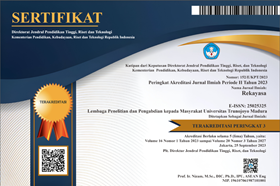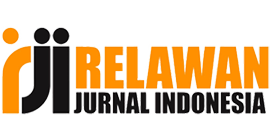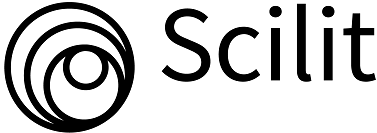Pengaruh Penambahan Konsentrasi Minyak Atsiri Nilam (Pogostemon cablin B.) Pada Formulasi Pembuatan Sampo Cair
Abstract
Shampoo is a personal care product formulated to cleanse and maintain the health of hair and scalp by removing impurities. Indonesia has significant potential to capture a share of the global shampoo market by leveraging its natural resources and traditional herbal ingredients. Patchouli essential oil, a notable ingredient in Indonesian products, contains patchouli alcohol, which serves as an effective antibacterial agent. This study aimed to examine the impact of incorporating light fraction patchouli oil into a liquid shampoo formulation and to evaluate the quality of the patchouli oil shampoo in accordance with the Indonesian National Standard (SNI) Shampoo 06-2692-1992. The research employed a laboratory-based experimental approach using a Completely Randomized Design (CRD). Treatments involved varying concentrations of patchouli oil added to the shampoo formulation: Z (0%), A (1.0%) (w/w), B (1.25%) (w/w), C (1.5%) (w/w), D (1.75%) (w/w), and E (2.0%) (w/w). The evaluation parameters included yield, moisture content, pH level, organoleptic properties, and antibacterial activity. Among the formulations, the shampoo with a 1.0% (w/w) concentration of patchouli oil (Treatment A) was identified as the optimal formula, with a yield of 87.122%, moisture content of 63.59%, pH of 6.74, and the highest bacterial inhibition zone at 16.75 mm. Results indicated that increasing the concentration of patchouli oil resulted in higher moisture content and pH levels, while yield and antibacterial activity decreased. All treatments met the standards set by SNI Shampoo 06-2692-1992, demonstrating that the addition of light fraction patchouli oil is effective and beneficial as a functional component in shampoo production.
Keywords
Full Text:
PDF (Bahasa Indonesia)References
Anjani, D. & Wali, A. R. (2023) Formulasi Sampo Cair Transparan dari Sari Buah Jeruk Nipis dan Wortel. Prosiding Seminar Nasional Teknologi Industri, Lingkungan dan Infrastruktur (SENTIKUIN) Vol 6 Tahun 2023, page A2.1-A2.13. Fakultas Teknik Universitas Tribhuwana Tunggadewi, Tersedia online di https://pro.unitri.ac.id/index.php/sentikuin
Arianti, R.K., & Hasni. (2010) Kinerja Perdagangan serta Strategi Ekspor Produk-Produk Pharmaceutical dan Kosmetik Berbasis Herbal Indonesia di Pasar Dunia. Buletin Ilmiah Litbang Perdagangan.4 (1): 14-30.
Badan Standardisasi Nasional. (1992). SNI 06-2692-1992: Sampo. Jakarta: Badan Standardisasi Nasional.
Cappuccino, J. G., & Sherman, N. (2014). Microbiology: A Laboratory Manual (10th ed.). Pearson. https://books.google.co.id/books/about/Microbiology.html?id=6W2JMQEACAAJ&redir_esc=y
Coyle, M. B. (2005). Manual of Antimicrobial Susceptibility Testing. American Society for Microbiology.
Cornwell, P.A. (2018) A review of shampoo surfactant technology: consumer benefits, raw materials and recent developments. International Journal of Cosmetic Science. 40(1):16-30. doi: 10.1111/ics.12439. Epub 2017 Dec 14. PMID: 29095493
Endarini, L. H. (2016). Farmakognosi Dan Fitokimia (1st ed.). Badan Pengembangan Dan Pemberdayaan Sumber Daya Manusia Kesehatan.
Erwiyani, A.R., Putri, R. A., Sunnah, I., Pujiasti, A. (2023).Formulasi dan Evaluasi Sampo Ekstrak Labu Kuning. Majalah Farmasetika. 8(2): 164 -174
Fauziyah, N. R., Widyasanti, A., Filianty F. (2020). Pembuatan Sampo Cair Berbahan Baku Minyak Kelapa (Coconut Oil) Dengan Penambahan Infused Oil Daun Mimba (Azadirachta Indica). 4(2): 87-94
Fauziyah, N. R., & Widyasanti, A. (2021). The Valorization Of Neem Leaves Infused Coconut Oil At Various Concentrations for the Production of Natural Liquid Shampoo. Advances in Food cience, Sustainable Agriculture and Agroindustrial Engineering. 4(2): 131-137
Isnaini, N., Syaifullah ,M.,, Prajaputra, V. Indra, I., Sufriadi, E., Ernawati, E., Riski, C.D. (2025). Hybrid function of Light Fraction Patchouli in Hair Care Formulations for Effective Hair and anti-Drandruff Treatment. Narra J. 5(2): e1622 https://doi.org/10.52225/narra.v5i2.1622
Iskandar, B. , Leny , Widodo, A. F. (2023) Sediaan Sampo Dari Ekstrak Etanol Daun Sintrong (Crassocephalum Crepidioides): Formulasi, Karakterisasi Fisik Dan Uji Aktivitas Anti Jamur. Majalah Farmasetika, 8 (5), 459-474 https://doi.org/10.24198/mfarmasetika.v8i5.47390
Iwata, H., & Shimada, K. (2013). Formulas, Ingredients and Production of Cosmetics. In Formulas, Ingredients and Production of Cosmetics. Springer Japan. https://doi.org/10.1007/978-4-431-54061-8
Januarti, I.B, & Rahmadani, L.W. A. (2024) Formulas Sampo Gel Kombucha Telang sebagai Anti Bakteri Staphylococcus epidermidis dengan Variasi Carbopol 940 dan Sosium Lauril Sulfat. INPHARNMED (Indonesian Pharmacy and Natural Medicine Journal). 8(1): 39-48
Jia, J., Duan, S., Sun, L., & Qin, C. (2021). Long-Term Antibacterial Film Nanocomposite Incorporated with Patchouli Essential Oil Prepared by Supercritical CO2 Cyclic Impregnation for Wound Dressing. MDPI. https://doi.org/doi.org/10.3390/molecules26165005
Moore, S. L. (1997). The Mechanisms of Antibacterial Action of Some Nonionic Surfactants. University of Brighton.
Nadiya, A. F., & Ishak, A. (2022). Analisis Niat Beli dan Perilaku Konsumen terhadap Produk Perawatan Kulit Ramah Lingkungan. Selekta Manajemen: Jurnal Mahasiswa Bisnis & Manajemen, 1(3), 186–204. Retrieved from https://journal.uii.ac.id/selma/article/view/25155
Nurjanah, S., Rosi, D. M., Fathoni, R. P., & Widyasanti, A. (2019). Aktivitas Antibakteri Minyak Nilam (Pogostemon Cablin Benth) Pada Beberapa Tingkat Kadar Patchouli Alcohol. Jurnal Teknologi Industri Pertanian, 29(3): 240-246 https://doi.org/10.24961/j.tek.ind.pert.2019.29.3.240
Kementerian Perdagangan, B. P. dan P. P. (2017). Peluang Ekspor Sampo Indonesia.
OEC. (2024). Perfumery & cosmetics in Indonesia. Observatory of Economic Complexity. https://oec.world/en/profile/bilateral-product/perfumery-cosmetics/reporter/idn
Saphira, V., & Mayangsari, V. (2023). Motif Pembelian dan Word of Mouth pada Konsumen Produk Skincare Lokal Organik
Jurnal Interaksi: Jurnal Ilmu Komunikasi, 12(1):73-84. https://doi.org/10.30596/ji.v8i1.14443
Somalwar, A. R., Somalwar, S., Sande, J. A., & Shete, V. V. (2022). Formulation and Evaluation of Herbal Anti-Dandruff Shampoo with Carica papaya Leaves Extract. Journal of Emerging Technologies and Innovative Research, 9(6), 94–99.
Uswah, U. N., Widyasanti, A., & Rosalinda, S. (2019). Perlakuan Bahan Baku Minyak Kelapa (Coconut Oil) dengan Variasi Konsentrasi Infused Oil Teh Putih (Camelia Sinensis) pada Pembuatan Sabun Cair. Jurnal Keteknikan Pertanian Tropis Dan Biosistem., 7(1), 67–77.
DOI
https://doi.org/10.21107/rekayasa.v18i2.27951Metrics
Refbacks
- There are currently no refbacks.
Copyright (c) 2025 Asri Widyasanti, Muhammad Hafyyan, S Rosalinda

This work is licensed under a Creative Commons Attribution-ShareAlike 4.0 International License.
























